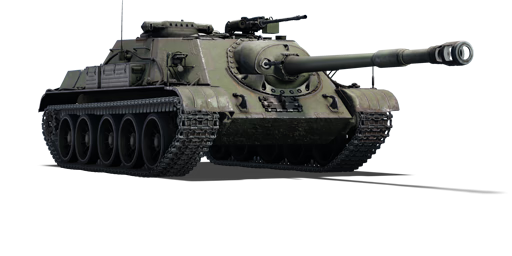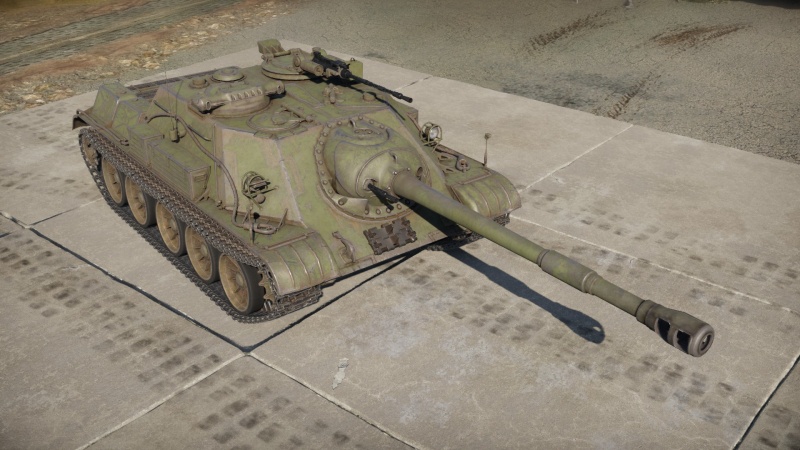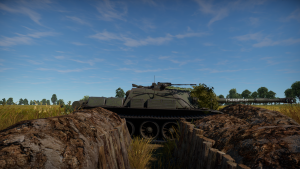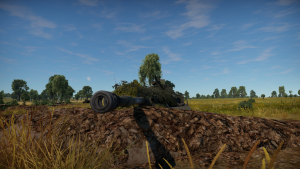SU-122-54
Contents
Description
The SU-122-54 is a rank V Soviet tank destroyer with a battle rating of 6.7 (AB/RB/SB). It was introduced in Update 1.49 (aka 1.70.1945) "Weapons of Victory". Featuring a T-54 chassis and similar ammunition in a tank destroyer format and a 122 mm gun, the SU-122-54 presents an interesting vehicle for Rank V battles.
General info
Survivability and armour
The SU-122-54 has similar but better armour than the ISU-152, ISU-122 and SU-122P. In terms of profile, it is almost the same as the SU-100 but has a wider hull with a more separated crew compartment. Overall, the SU-122-54 is protected decently from all sides, except from the engine deck and crew compartment rear, which are only able to withstand 37 mm at point blank. Roof armour is lacklustre when it comes to protection against enemy planes, but most of the time aircraft strafes are made in an angle which makes the 20 mm plate becomes a 40 mm plate of effective armour, making the SU-122-54 a safe tank to play against planes with 20 mm cannons and even 37 mm. If seen from a frontal perspective with the SU-122-54 having bushes, it is often confused with the JPz 4-5 due to the mantlet shape, muzzle break and general frontal hull structure.
The small profile makes the SU-122-54 an easily hideable tank between relatively small bushes or trenches (as seen in pictures), the use of add-on camouflage can make the SU-122-54 a ghost in all environments (with exception of fully urban). The armour is capable of withstanding direct hits from 75 mm KwK PzGr 39/42 (ammunition of the Panther tanks with 193mm of penetration at 10m at 0°) and American 75 mm and 76 mm (M3 cannon for example of the M4 Sherman family, 17pdr of the British Sherman Firefly and the 75 mm SA50 of the M4A4 (SA50)) with exception of trap shots done to the mantlet (only weakspot of mantlet is the optics) which are highly unlikely to happen. When it comes to higher calibres (88 mm, 122 mm, etc), the SU-122-54 has a few strong points that will withstand most enemy rounds but won't be reliable enough to count on all the time. It is safe to be fired at in ranges between 400-700 m (specially since, at those distances, enemy tanks will have a hard time aiming at the SU-122-54 due to its small profile) but at close ranges (0-350 m) it may not withstand said rounds. Always act as if they will penetrate your hull and try to avoid being shot; by doing this you reduce the chances of the enemy of killing you in the case they are capable of penetrating your hull.
Regarding crew compartment, despite being tight and small, it has a high survivability specially for the number of crew members and the huge breech of the 122 mm cannon (they will most likely destroy your breech with a side shot but it will stop most of the spalling). The ammunition is located at the rear of the crew compartment (in front of engine deck) an below the main gun in front of driver and gunner. This makes the SU-122-54 one of the hardest tanks to ammo rack at the battle rating (as most of the enemies in RB will fire at center of mass where your breech will stop the spalling). The tank has a crew amount of 5 crewmen: driver, gunner, commander and two loaders, one of them is the machine gunner (left one if seen from behind).
It should not be played as fast as the JPz 4-5, firing and then running away from any threat, but it cannot play as a bastion defence either.
Armour type:
- Rolled homogeneous armour
- Cast homogeneous armour (Gun mantlet, Commander cupola)
| Armour | Front | Sides | Rear | Roof |
|---|---|---|---|---|
| Hull | 100 mm (50°) Front glacis 100 mm (54-55°) Lower glacis |
80 mm | 45 mm (17°) | 20 mm |
| Superstructure | 100 mm (50°) Front glacis 100 mm (41°) Side joint plate 100 + 100 mm (7-65°) Gun mantlet |
80 mm (26°) | 30 mm (21°) | 20 mm |
Notes:
- Suspension wheels are 20 mm thick while tracks are 30 mm thick.
Mobility
| Game Mode | Max Speed (km/h) | Weight (tons) | Engine power (horsepower) | Power-to-weight ratio (hp/ton) | |||
|---|---|---|---|---|---|---|---|
| Forward | Reverse | Stock | Upgraded | Stock | Upgraded | ||
| Arcade | 55 | 9 | 36 | 739 | 992 | 20.53 | 27.56 |
| Realistic | 51 | 8 | 460 | 520 | 12.78 | 14.44 | |
The SU-122-54 is not as fast as compared with other turretless tank destroyers as the JPz 4-5 but not as slow as the Jagdtiger, it is safe to say that it is somewhere in the middle, while using armour similar to Jagdpanther.
As the rest of the Russian tanks, it lacks neutral steering and reverse speed, but it is compensated with a high horsepower.
As a downgrade from SU-100, it has a very rocky suspension, like spaded ZiS-30, so it's recommended not to brake before firing, but to slow down instead. It is also very unstable when climbing and will slide off some sniper spots even with all the mobility upgrades, which let it climb better.
If it manages to rush a steep hilltop or a cliff, it has a tendency to fly right off the cliff before managing to stop. If user somehow managed to stay on top of a cliff, the rocky suspension will force it to stabilise for about 3 to 5 seconds before any reasonable aim can be taken.
Modifications and economy
Armaments
Main armament
Overall, the SU-122-54 can be considered as a hybrid between the SU-122P and T-54 (1951). It does not have a stabiliser, has APHE of an SPG and also ammunition expected for medium tanks of the next era. Has shorter reload than SU-122P but longer than T-54s.
The main gun is capable of defeating all vehicles frontally at the BR it sits at, but for some the HEAT-FS or APDS should be used, as BR471B often fails to penetrate angled tanks.
| 122 mm D-49 | Turret rotation speed (°/s) | Reloading rate (seconds) | |||||||||||
|---|---|---|---|---|---|---|---|---|---|---|---|---|---|
| Mode | Capacity | Vertical | Horizontal | Stabilizer | Stock | Upgraded | Full | Expert | Aced | Stock | Full | Expert | Aced |
| Arcade | 35 | -4°/+16° | ±8° | N/A | 6.16 | 8.53 | 10.36 | 11.46 | 12.19 | 15.99 | 14.15 | 13.04 | 12.30 |
| Realistic | 4.17 | 4.90 | 5.95 | 6.58 | 7.00 | ||||||||
Ammunition
APCBC:
This is the first ammunition the SU-122-54 has access to (BR471, BR471B and BR471D) which is sometimes considered as the "weak" ammunition, as it often fails to penetrate tanks in full up-tier. Despite having a "low" penetration (BR471 has 203 mm at 10 m at 0° and BR471D 239 mm at the same distance and angle) it should not be underestimated. BR471B should be your main ammunition in almost all sorts of engagements, as it has the highest angled penetration. The BR471D has the penetration to deal with all heavy tanks frontally (with exception of Tiger 2 tanks glacis, Maus, E-100 and some frontal places of the glacis of the T-29/T-34). Both generally have enough fuse sensitivity to explode inside lightly armoured vehicles. These two rounds are a 90% confirmed one shot kill due to their tremendous explosive power (246.4 or 192.5 g of TNT equivalent respectively). APHECBC should not be underestimated.
APDS:
This is the most reliable round to use at distances when speed or ease of aim is crucial (Shell velocity of 1,400 m/s). It has enough penetration to deal the glacis of Tiger II tanks as well as T29/T34 but, due to being a solid shot subcalibre round, it has no explosive power. This means the APDS relies on spalling created by the armour penetration, which can sometimes be difficult to utilise, particularly if killing the enemy vehicle has to be done as soon as possible. This does not mean that the APDS cannot destroy tanks in one shot - if aimed at ammunition or center of mass it often can do that. Tiger II tanks will be destroyed with a single shot at the glacis if the shot is made right at the middle of the glacis. This round should be mostly be used as a secondary round for heavily armoured targets or at far ranges in which a high velocity round is preferable.
HEAT-FS:
This is the round with the most consistent penetration due to being chemical energy, being slightly stronger than HEAT-FS of 6.3 japanese tanks and on par with 7.7 and 8.7 HEAT-FS but at 6.7. This round can be considered the most reliable round for all sorts of engagements both at close range or at distance if one shot kills are not planned or an enemy cannot be penetrated by APHECBC. It has a great explosive power (2.05 kg of TNT equivalent) but, due to being a hollow charge, the spalling is focused in a cone shape, like APDS. Similar to APDS, this round has to be aimed at center of mass to damage as most modules and crewmates as possible due to the tightly packed spalling created. It should be noted that this round requires a clear flight path to the target as trees, bushes, fences and any obstruction will detonate it due to the fuse sensitivity, so it cannot replace APDS entirely, at least on large forest maps. Keep this in mind.
| Penetration statistics | |||||||
|---|---|---|---|---|---|---|---|
| Ammunition | Type of warhead |
Penetration @ 0° Angle of Attack (mm) | |||||
| 10 m | 100 m | 500 m | 1,000 m | 1,500 m | 2,000 m | ||
| BR-471 | APHE | 205 | 201 | 183 | 162 | 144 | 128 |
| BR-471B | APHEBC | 205 | 203 | 191 | 178 | 166 | 155 |
| BR-471D | APCBC | 230 | 227 | 215 | 200 | 186 | 173 |
| 3BM-7 | APDS | 299 | 298 | 291 | 272 | 253 | 249 |
| 3BK-10 | HEATFS | 400 | 400 | 400 | 400 | 400 | 400 |
| OF-471 | HE | 37 | 37 | 37 | 37 | 37 | 37 |
| Shell details | |||||||||
|---|---|---|---|---|---|---|---|---|---|
| Ammunition | Type of warhead |
Velocity (m/s) |
Projectile Mass (kg) |
Fuse delay (m) |
Fuse sensitivity (mm) |
Explosive Mass (TNT equivalent) (g) |
Ricochet | ||
| 0% | 50% | 100% | |||||||
| BR-471 | APHE | 795 | 25 | 1.2 | 19 | 246.4 | 47° | 60° | 65° |
| BR-471B | APHEBC | 795 | 25 | 1.2 | 19 | 246.4 | 48° | 63° | 71° |
| BR-471D | APCBC | 800 | 25 | 1.2 | 19 | 192.5 | 48° | 63° | 71° |
| 3BM-7 | APDS | 1,400 | 5.4 | N/A | N/A | N/A | 75° | 78° | 80° |
| 3BK-10 | HEATFS | 820 | 18.4 | 0.05 | 0.1 | 2,050 | 65° | 72° | 77° |
| OF-471 | HE | 800 | 25 | 0 | 0.1 | 3,600 | 79° | 80° | 81° |
Ammo racks
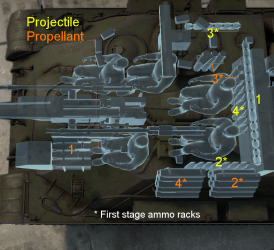
| Full ammo |
Ammo part |
1st rack empty |
2nd rack empty |
3rd rack empty |
4th rack empty |
Visual discrepancy |
|---|---|---|---|---|---|---|
| 35 | Projectiles Propellants |
28 (+7) 28 (+7) |
14 (+21) 23 (+12) |
8 (+27) 9 (+26) |
1 (+34) 1 (+34) |
No |
Machine guns
The 14.5 mm KPVT can be considered as the most reliable HMG (Heavy Machine Gun) in game due to its stopping power and rate of fire. It is a Jack-of-all-Trades when it comes to ground battles, has a faster muzzle velocity than 20 mm cannons but has more destructive power than the 12.7 mm (.50 cal) machine gun. It does not get the fire rate of the 15 mm MG 151 HMG (HMG mounted on the AMX-50 Foch), but also will not overheat and jam, thus can be fired indefinitely.
The KPVT are exclusive to Russian tanks and are able of doing multiple things:
- Immediate ground defence: these machine guns are able to damage and destroy external components of all tanks (tracks, gun barrels, etc), destroy lightly armoured vehicles (with armour thinner than 30 mm at a slight angle, at maximum of 200 m range), obstruction removal (continuous focused fire can destroy even some solid walls) and can be used for spotting in RB. Make sure to focus both MGs on a gun barrel, as just one KPVT will not break the gun by itself with one belt.
- Immediate air defence: due to having a roof mounted KPVT with a 360° rotation and a 40° elevation, it is able to critically damage low flying aircraft. This belts have AP-I round which can cause fatal damage on all low flying aircraft (it often lits them on fire or damages the engine).
| 14.5 mm KPVT | ||||
|---|---|---|---|---|
| Mount | Capacity (Belt) | Fire rate | Vertical | Horizontal |
| Coaxial | 300 (50) | 600 | N/A | N/A |
| Pintle | 300 (50) | 600 | -5°/+60° | ±180° |
Usage in battles
The SU-122-54 is far from being a frontline tank, meaning it has to stay away from the enemy LoS (line of sight) due to the long reload and relatively weak armour. This does not mean the SU-122-54 should be taken all the way through the outskirts of a map to get into position (can be done but not recommended on all maps). It should be used as a sniper in long range maps and a support vehicle in the rest. It is able to defend itself pretty well if a good defensive position is found or set. All CQC (close quarters combat) should be avoided as the lack of turret invites enemy tanks to flank you from all sides but frontally which is the only side you can defend yourself from. Some places in CQC environments (urban areas, city ravines, etc) can be used as stroke point (holding a full street waiting for someone to push if that street is the only access point) due to its powerful gun and decent armour. This tank faces almost nothing that can be a hard cookie to crack.
List of opponents important notes when facing frontally:
- Panther/M48/Pershing: all front can be penetrated with BR471D and higher penetration rounds. Do not use 3BK-10
- M60: gun mantlet can be penetrated by BR471D, hull has to be penetrated by 3BM-7 or 3BK-10
- Tiger II: gun mantlet can be penetrated by BR471D, hull has to be penetrated by 3BM-7 or 3BK-10 (aim at right side of the turret if the tank is facing at you for a safe reload)
- Centurion: all front can be penetrated with BR471D and higher penetration rounds
- M103: hull has to be penetrated by 3BM-7 or 3BK-10, center of mass shot has to be done frontally as the hull and turret are curvy
- T32/T32E1: gun mantlet and hull have to be penetrated by 3BM-7 or 3BK-10, aim at lower half of the frontal glacis to fire at ammunition rack
- Maus/E-100: gun mantlet has to be penetrated by 3BM-7 or 3BK-10, hull has to be penetrated by 3BK-10. Side shots have to be done with 3BM-7 or 3BK-10.
- Jagdtiger: gun mantlet and hull have to be penetrated by 3BM-7 or 3BK-10
- Leopard 1/AMX-30: all front can be penetrated with BR471D and higher penetration rounds
- T95: gun mantlet and hull have to be penetrated by 3BM-7 or 3BK-10
Pros and cons
Pros:
- Strong gun that can fire HEAT-FS or APDS shells, unlike most other 122 mm gun-equipped tanks with a improved fire-rate, makes it viable in up-tiers
- Fairly low silhouette
- Has two 14.5 mm machine guns, actually useful to mess with heavier opponents and to ward off low-flying aircraft or light vehicles
- Decently mobile, but will not climb well until upgraded
- Good top speed
- Has access to a rangefinder and NVD
- Mantlet can have effective thickness of 200 mm at certain angles of attack, though it's not very reliable
Cons:
- Long reload stock (16 seconds), though not as long as most other 122 mm
- The protection is not as adequate at close range
- Restricted firing angles for the main guns, horizontally and vertically, due to casemate mounting
- Due to a poor stability of chassis, braking is not recommended when encountering an enemy tank
- Lack of a turret means that if you get flanked, the tank is in serious trouble
- 14.5 on top of the tank can't turn to the right, and many light tanks at the BR prefer to attack from your right (to protect their vulnerable left side)
- Cupolas hits will injure respective crew members
- Two loaders means the rate of fire suffers strongly in the event of a penetration
- The armour is thick enough to hamper acceleration
History
The success of the T-54 tank in the early 1950s had the vehicle chassis used in many different variants for different roles. The roles range out from a self-propelled anti-aircraft gun, armoured recovery vehicle, bridge-layers, mine-clearers, flamethrowers, armoured personnel carriers, fire-fighting vehicles, and a self-propelled gun. The self-propelled gun, known as "Object 600", was a vehicle based off the T-54A design and carried the 122 mm gun infamous on the IS heavy tank series. The vehicle was known as the SU-122-54, but it has sometimes also be referred to as the IT-122 as well. The chassis was modified for the vehicle, with the large gap present between the first and second road wheels moved to between the third and fourth. The superstructure, like traditional designs, was built onto the hull and held the 122 mm gun. Secondary armament consisted of two KPVT heavy machine guns on coaxial and pintle-mount for anti-aircraft purposes. The general design was developed and built between 1955 and 1957, with a total of 77 units made with minor differences between each batch.
In-game description
The SU-122-54 self-propelled artillery mount was constructed on the basis of the T-54-55 medium tank from 1948 to 1951. It was intended first and foremost to play the role of an assault and antitank weapon. Plans were made for large-scale production of the SU-122, but starting in 1957 its release was curtailed due to a shift in the priorities of military production in favor of building missile weapons.
The SU-122-54 SPG was used by the Soviet Army until the second half of the 1960s, when it was removed from the army's arsenal. A total of 77 SU-122-54 SPGs were produced.
Media
Excellent additions to the article would be video guides, screenshots from the game, and photos.
See also
Links to the articles on the War Thunder Wiki that you think will be useful for the reader, for example:
- reference to the series of the vehicles;
- links to approximate analogues of other nations and research trees.
External links
| USSR tank destroyers | |
|---|---|
| SU-76M | SU-76M · SU-76M (5th Gv.Kav.Corps) · SU-85A |
| SU-57B | SU-57B · SU-76D |
| T-34 Derivatives | SU-122 · SU-85 · SU-85M · SU-100 · SU-122P |
| Heavy Tank Derivatives | SU-100Y · ISU-122 · ISU-122S · SU-152 · ISU-152 · Object 268 |
| SU-100P and Derivatives | SU-100P · Object 120 |
| Wheeled | YaG-10 (29-K) |
| Airborne | ASU-57 · ASU-85 |
| Rocket | BM-8-24 · BM-13N · BM-31-12 |
| ATGM | IT-1 · Shturm-S · Object 775 · Khrizantema-S |
| Artillery | 2S1 · 2S3M |
| Other | SU-5-1 · ZiS-30 · SU-122-54 |
| USA | SU-57 |


